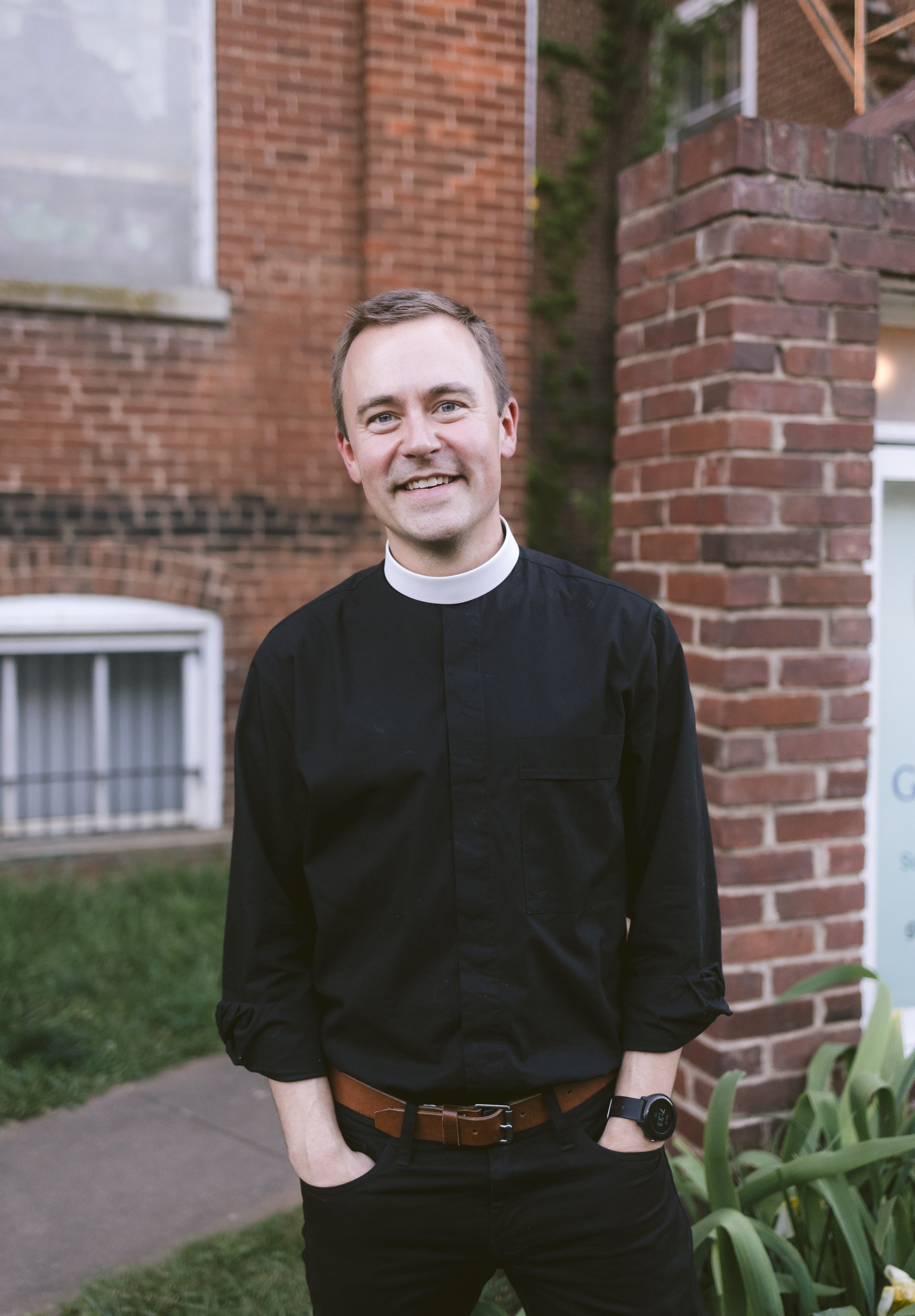The Wounds of God for the People of God
by Robert Cunningham
This article originally appeared digitally here. Mockingbird is an organization devoted to “connecting the Christian faith with the realities of everyday life”.
About a year and a half ago, I was ordained as a priest. There are many weird, beautiful, and mysterious things that happen in an ordination service, but one in particular that has lingered with me was having my hands marked with oil. In this act, a priest’s hands are specifically being “set apart” for the priestly work of absolving, blessing, and consecrating. Regardless of one’s familiarity with these things or these terms, ever since that day, I’ve just been way more aware of my hands — as I place my hand on the shoulder of a weary friend, anoint the forehead of a parishioner in a hospital bed, or caress my children’s heads. Our hands have such power to break or bless, to harm or heal.
And, surely, we all feel this to ever greater degrees with each technological advance. If there’s one way technology has impacted us, it has amplified the usage of and perceived power of our hands. Some go so far as to argue that it’s actually changing our hands. We have touch screens everywhere. The simple touch of a finger can power on or off and control a powerful machine. With just the touch of a finger — a swipe, a scroll, a click — we can carry out powerful acts of approval, condemnation, connection, canceling, and more.
As I’ve grown more conscious of this, I’ve become particularly aware that my hands are not just mine. “You” — which includes our hands — “are not your own,” as Paul tells us. They are, mysteriously, marked as conveyors of God’s touch, if you will. And as such, they are set apart not only to hold “weighty” things but also participate in the “hands on” ministry of Jesus.
If there’s anything we learn about “hands” and “touch” from Jesus’ ministry it’s that God touches and holds wounds. So much of what we see of Jesus’ ministry is the ministry of the safe handling of vulnerable realities. Throughout the gospels, Jesus opens his hands to wounded people: the hand of a 12 year-old dead girl; the eyes of blind men; the ears of the deaf; the tongue of the mute; the body of a leper. Look for the places in the gospels where that word “touch” shows up. It’s quite revealing. And startlingly intimate.
It’s this aspect of Jesus’ ministry that has often been at the forefront of my mind as I’ve inhabited the priesthood. I feel this as acutely as any time during that part of the Eucharistic liturgy in which I lift up the paten and the chalice and proclaim, “The gifts of God for the people of God.” Internally, I often see what I’m holding in my hands — bread and wine — and want to say, “The wounds of God for the people of God.” Is there anything more sacred than holding someone’s wounds? Placing your hands on the most vulnerable parts of their life, their story? It almost seems too much for us; perhaps, sometimes it is. That’s what we see in so many of the beautiful expressions of Jesus’ ministry in the gospels. And mysteriously, this is precisely what we are invited to do every week in corporate worship. I suppose that’s the whole point. What do we need more than to know that our wounds are not too much for the story of Jesus or off limits of the hands of Jesus, and even more, that it is precisely the wounds of God that bring healing to our own?
This has taken on a whole new meaning for me in my latest reading of the Lord of the Rings with my son. He’s only 7 years old, which means (when I’m actually being the kind of parent I want to be) I read it quite slowly, pausing both for clarifications and random rabbit trails of thought from a 7-year-old. And this time around, I’ve been struck by Frodo’s woundedness. Before he even makes it to the council in The Fellowship of the Ring, he’s dealt a horrific wound. Stabbed in the shoulder by a creature and a weapon that straddle the material and spiritual worlds. This is a pretty vivid depiction of some of the deepest wounds in our own lives, those pains that were experienced in the mysterious intersection of the material and physical. These wounds may or may not leave a physical scar in their wake, but at a deeper level, they leave a scar on our soul, pains and aches that linger and often seem beyond remedy.
And yet, it’s the wounded Frodo — not some idealized, invulnerable Frodo — who is called into and caught up into a revolutionary mission, journey, and story. And that’s often who we are as those caught up into the mission, journey, and story of Jesus. It’s the wounded “you”, the wounded “me” — not some totally cleaned up, invulnerable “self” who has already “arrived” — that Jesus loves, calls, and journeys with.
Even more, Frodo’s wound is regularly re-triggered on the journey. He still carries his past with him. His body still keeps the score, even as he is partaking of the adventure of new life. And even after accomplishing the mission, heroically resisting evil and destroying the ring, the ache of his wound lingers. The hidden scar remains. “There are some wounds that cannot be wholly cured,” as Gandalf says it. So too our own wounds and scars in our pilgrimage with God.
This thread in Lord of the Rings has had me reflecting on the wounds of the risen Jesus. One of the most peculiar features of many of his post-resurrection appearances is his (almost awkward and unbearable) insistence that his disciples see, touch, witness his wounds, his scars. It seems there is something integral to who God is, to how his story holds ours, that cannot be fully grasped apart from dealing with the resurrected wounds of Jesus.
In Jesus, we encounter resurrected scars. At one level, this means that “he knows.” He knows the experience of woundedness. He is acquainted with our pain, our aches. He knows the hell of the wounding that happens at the nexus of material and spiritual. And at the very least, we’re meant to see that his wounds are capacious enough for all of ours. There is no part of your life or story that cannot be held in Jesus’ scars.
And yet, in Jesus we also encounter resurrected scars. That is to say, though his scars remain, they are also transfigured. This does not mean that, when confronted with our wounds, we piously downplay evil or impose some silver-lined rendition of “everything happens for a reason” on them. Rather, it means, in some mysterious way, that our scars do not have the last word. Think about it. What is a scar but a physical reminder that “it” — whatever horror that “it” was or is — was not the end of you? And if Jesus’ scars tell us anything, they tell us that there is no evil in the world that is too much for God to enter into it and bring about life, even transfiguration. In God’s economy, wounds can become iridescent sites of resurrection power and glory. Again, this does not downplay the pain but instead underscores the greater power of resurrection life.
When reflecting on the scars of the martyrs toward the end of his lovely tome The City of God, St. Augustine mused that perhaps it is wounds that actually have the greatest capacity to reflect resurrection glory. Those places in our lives and on our bodies that seemed most dead or hopeless that have the greatest capacity to reveal God’s power and life.
What that will look like, we can’t say with certainty. And it’s certainly not something one can rush or conjure up in their own strength. Like many aspects of the Christian pilgrimage, it’s slow, communal, animated by faith, hope, and love, and ultimately, reliant on the power and love of God. But we are certainly given license to hope in this direction. And that hope is not just an idea but something you can also hold in your hand. For it is precisely in the wounded body of Jesus — “the wounds of God for the people of God” — offered to us each week, placed into our very hands, that we receive the only medicine sufficient for our wounds. And in a mysterious way, in receiving them in our hands, we place our selves, wounds and all, into the wounded hands of Jesus.
The Rev. Robert Cunningham is the Vicar at Church of the Good Shepherd in Charlottesville, VA.

